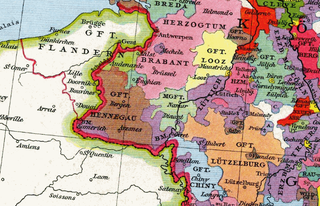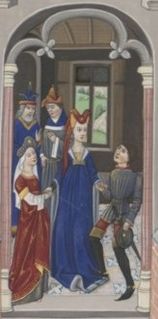
The County of Loon was a county in the ancien regime Holy Roman Empire, which corresponded approximately with the Belgian province of Limburg. It was named after the original seat of its count, Loon, which is today called Borgloon. During the middle ages the counts moved their court to a more central position in Kuringen, which is today a part of neighbouring Hasselt, the modern capital.

Louis II was count of Loon between the end of the 12th century to 1218. He was the son of Gerard, Count of Looz, and Adelaide of Gelderland, daughter of Henry I, Count of Guelders, and Agnes of Arnstein, daughter of Louis III of Arnstein. He also claimed to be the legitimate Count of Holland during the Loon War (1203–1206).
Henry I, Count of Guelders (1117–1182) was Count of Guelders from 1131 until 1182. He was a son of Gerard II of Guelders and Ermgard of Zutphen.

Arnold IV of Loon (Looz), was Count of Loon from 1227 to 1273 and Count of Chiny from 1228 to 1268. He was the son of Gérard III, Count of Rieneck and Cunegonde von Zimmern.

Louis I, Count of Loon (Looz) was the Count of Loon, which he inherited from his father. He ruled from approximately 1139 until his death.
The Counts of Chiny were part of the nobility of Lotharingia that ruled from the 9th to the 14th century in what is now part of Belgium. The County of Chiny was created in the early 10th century out of the ancient county of Ivois. The county now forms part of the province of Luxembourg in present-day Belgium. The county of Chiny included the present-day cantons of Virton, Etalle, Florenville, Neufchâteau, Montmédy and Carignan, as well as the castles of Warcq on the Meuse, which was built in 971 by Otto, ancestor of the later Counts of Chiny. There is a close relationship between the Counts of Chiny and the Counts of Looz, the Counts of Verdun and the Bishops of Verdun.
Otto II, Count of Chiny, son of Arnold I, Count of Chiny, and Adélaïs.
Louis IV the Young, Count of Chiny from 1189 to 1226, son of Louis III, Count of Chiny, and Sophie. Louis was the last of the first dynasty of Counts of Chiny. Having no son, he prepared his eldest daughter Jeanne as his successor. Louis marked his reign by issuing the first postage stamp in the county.
Joan was the Countess of Chiny. Joan was the daughter of Louis IV, Count of Chiny, and Matilda of Avesnes, and became ruler of the county upon her father’s death on 7 October 1226. She married Arnold IV, Count of Loon, son of Gerard III, Count of Rieneck, and Kunigunde von Zimmern, in 1228, whereupon he assumed the role of Count of Chiny.
John I (Jean), Count of Looz and Count of Chiny, eldest son of Arnold IV, Count of Looz and Chiny, and Jeanne, Countess of Chiny. He succeeded his father in 1272 or 1273, as the Count of Looz and Chiny. Virtually nothing is known about his reign.
Diederik of Heinsberg, Count of Loon and Count of Chiny (1336-1361), was the son of Godfrey II, Lord of Heinsberg, and Matilda.
Godfrey de Heinsberg, Lord of Daelenbroeck, Count of Looz and Count of Chiny (1361-1362), son of John of Heinsberg, Lord of Daelenbroeck, son of Arnold V, Count of Looz and Chiny, and Catherine de Vroon.
Arnold I, Count of Looz (Loon), son of Emmo, Count of Loon, and Suanhildis, daughter of Dirk III, Count of Holland, and his wife Othelandis.
Gérard "I" is a wrongly proposed Count of Loon (Dutch), or Looz (French), in what is now Belgian Limburg, who was supposedly mentioned in an 1101 charter of Emperor Henry IV concerning the return of the town of Andenne by Albert III, Count of Namur. There is general consensus that he did not exist.
Arnold II, Count of Looz, son of Arnold I, Count of Looz, and Agnes von Mainz, daughter of Gerhard I, Count of Rieneck, and Helwig von Bliescastel. He is distinguished from his father of the same name by historians who note records for counts named Arnold or Arnulf between 1179 and 1141. The first Arnold must have died between 1125 when Count Arnold appears in a record with his son also named Arnold, and 1135, when a new Count Arnold appears with his own son and successor Louis.
Count Gerard of Loon, was son and successor of Louis I, Count of Loon, and Agnes of Metz. Because of a widespread misunderstanding concerning a document from 1101, some generations earlier, he is often wrongly referred to as the second Gerard in this dynasty, "Gerard II".
Henry, Count of Looz and Count of Duras, son of Gérard II, Count of Looz, and Adelaide of Gelderland, daughter of Henry I, Count of Guelders, and Agnes of Arnstein, daughter of Louis III of Arnstein.
Arnold III, Count of Looz and Count of Rieneck, son of Gérard II, Count of Looz, and Adelaide of Gelderland, daughter of Henry I, Count of Guelders, and Agnes of Arnstein, daughter of Louis III of Arnstein.
Louis III, Count of Rieneck and Count of Looz. He was the son of Gérard III, Count of Rieneck, and Cunegonde von Zimmern.
John II ,, Lord of Jülich, Heinsberg and Löwenberg, son of Godfrey de Heinsberg, Count of Looz, and Philippa of Jülich, daughter of William V, Duke of Jülich, and Joanna of Hainaut. Although John was the first son of Godfrey, he did not inherit the countship of Looz, the title instead going to Arnold of Rumingy.